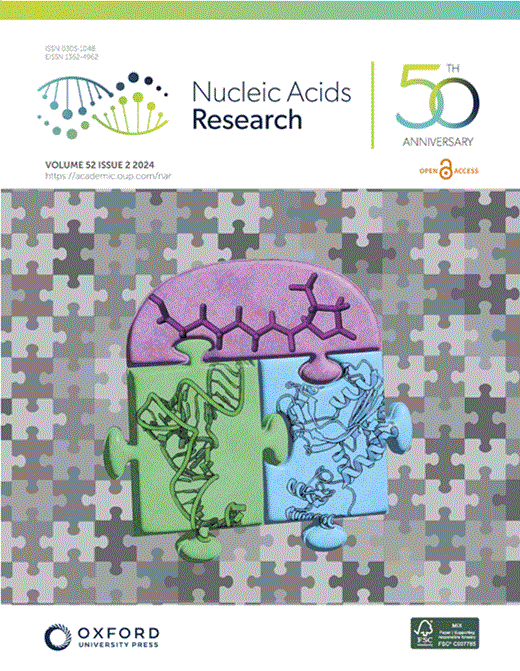Regulation of a phage defence island by RptR, a novel repressor that controls restriction–modification systems in diverse bacteria
IF 16.6
2区 生物学
Q1 BIOCHEMISTRY & MOLECULAR BIOLOGY
引用次数: 0
Abstract
Bacteria encode a panoply of defence systems to overcome phage infection. In recent years, over 100 defence systems have been identified, with the majority of these found co-localized in defence islands. Although there has been much progress in understanding the mechanisms of anti-phage defence employed by bacteria, far less is known about their regulation before and during phage infection. Here, we describe RptR (RMS-proximal transcriptional regulator), a small transcriptional regulator of a defence island in enteropathogenic Escherichia coli composed of a toxin–antitoxin system, DarTG2, embedded within a Type I restriction–modification system (RMS). We determined the molecular structure of a RptR homodimer and, using transcriptional reporter and in vitro DNA binding assays, show that RptR represses the promoter of the defence island by binding to a series of three direct repeats in the promoter. Furthermore, we demonstrate, using the structural models of RptR validated with electrophoretic mobility shift assays, that the minimal RptR binding site is a 6-bp palindrome, TAGCTA. Both RptR and its binding site are highly conserved across diverse bacterial genomes with a strong genetic association with Type I RMS, highlighting the role of RptR as a novel regulatory component of an important mechanism for anti-phage defence in bacteria.RptR对噬菌体防御岛的调控,RptR是一种新型的抑制因子,可以控制多种细菌中的限制性修饰系统
细菌编码了一整套防御系统来克服噬菌体感染。近年来,已经确定了100多个防御系统,其中大多数都分布在防御岛屿上。尽管在了解细菌使用的抗噬菌体防御机制方面取得了很大进展,但对它们在噬菌体感染之前和期间的调节知之甚少。在这里,我们描述了RptR (RMS-近端转录调节剂),这是肠致病性大肠杆菌防御岛的一个小转录调节剂,由毒素-抗毒素系统DarTG2组成,嵌入在I型限制性修饰系统(RMS)中。我们确定了RptR同型二聚体的分子结构,并使用转录报告基因和体外DNA结合试验,表明RptR通过结合启动子中的一系列三个直接重复序列来抑制防御岛的启动子。此外,我们利用经电泳迁移率转移试验验证的RptR结构模型证明,最小的RptR结合位点是一个6 bp的回文,TAGCTA。RptR及其结合位点在不同的细菌基因组中高度保守,与I型RMS有很强的遗传关联,这突出了RptR作为细菌抗噬菌体防御重要机制的新调控成分的作用。
本文章由计算机程序翻译,如有差异,请以英文原文为准。
求助全文
约1分钟内获得全文
求助全文
来源期刊

Nucleic Acids Research
生物-生化与分子生物学
CiteScore
27.10
自引率
4.70%
发文量
1057
审稿时长
2 months
期刊介绍:
Nucleic Acids Research (NAR) is a scientific journal that publishes research on various aspects of nucleic acids and proteins involved in nucleic acid metabolism and interactions. It covers areas such as chemistry and synthetic biology, computational biology, gene regulation, chromatin and epigenetics, genome integrity, repair and replication, genomics, molecular biology, nucleic acid enzymes, RNA, and structural biology. The journal also includes a Survey and Summary section for brief reviews. Additionally, each year, the first issue is dedicated to biological databases, and an issue in July focuses on web-based software resources for the biological community. Nucleic Acids Research is indexed by several services including Abstracts on Hygiene and Communicable Diseases, Animal Breeding Abstracts, Agricultural Engineering Abstracts, Agbiotech News and Information, BIOSIS Previews, CAB Abstracts, and EMBASE.
 求助内容:
求助内容: 应助结果提醒方式:
应助结果提醒方式:


